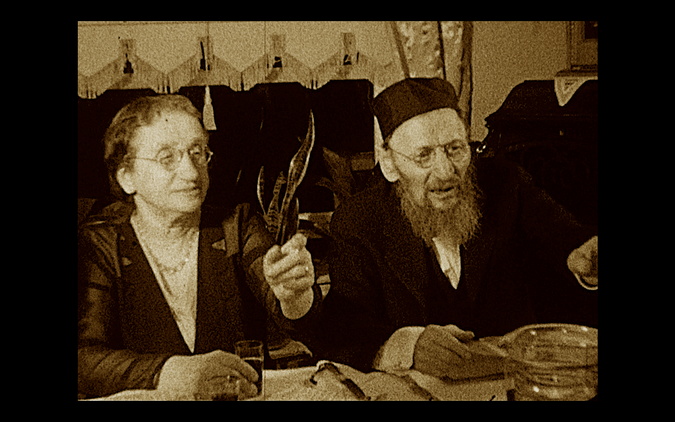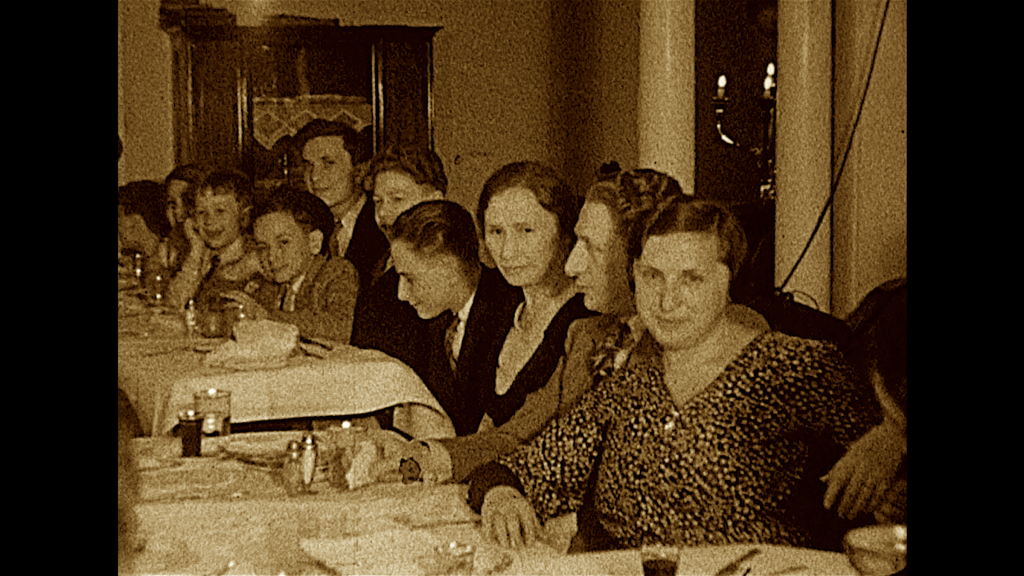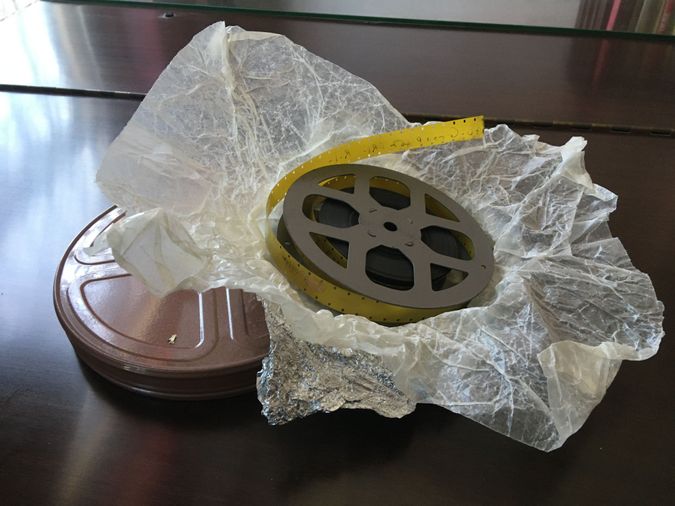VIDEO: Watch this rare home film of a Seder in 1932
Ruth Katcher, whose great-grandfather is leading the seder, shares the digitized version of the film.
This story was originally published in the Forward. Click here to get the Forward's free email newsletters delivered to your inbox.
After my mother died, I found a dusty tote bag in my parents’ cellar, stuffed with reels of film from our growing-up years. The film had been converted to digital form long ago, and I’m not even sure why I kept it. The tote bag migrated to a dark corner of my closet until last summer, when I thought to look inside and found a reel I’d never noticed before. It was wider than the other reels, 16mm rather than 8mm. Instead of a metal storage canister, it had been wrapped in wax paper and aluminum foil, like a sandwich.
Carefully unspooling a few feet, I saw “Passover Feast 1932,” followed by my great-grandfather’s name. After the title, the first frames showed a man and woman, he in an old-fashioned kippah, seated at the head of a long table. I recognized them as my father’s mother’s parents.

Old film is fragile; I didn’t dare unwind it further. I sent the reel out to an archival film house to be restored and digitized, and weeks later, I clicked on a link.
The film was now a file, a little under four minutes long, documenting a seder with about 30 people squeezed around a table covered in white cloths. Hagaddahs are handed out; my bearded great-grandfather reads aloud; wine glasses are filled and emptied. Matzoh appear on the table. Women move behind the chairs, their seats empty, as the meal is served. My grandmother, impossibly young and elegant, asks a child to make room for another place setting; my grandfather chats earnestly with a niece. My father, aged six, grins broadly, looking excited to be with his older cousins. Children squirm and jostle; a small boy cuts meat with an upside-down knife; young women flirt with the camera, nibbling on candied fruit. Teacups are filled from an enormous samovar.
A framed photograph on a bookshelf shows my great-grandparents in the center, surrounded by their six grown children and their spouses. I have a copy of this photo, which might have been taken a few years earlier, perhaps when my grandmother’s youngest brother was married in 1929. In the photograph, everyone is still, formally posed. But in the film, they laugh, joke, chew, nudge a neighbor. Some appear self-conscious in front of the camera, but most are focused on one another.
In the spring of 1932, when this seder was held, Franklin Roosevelt was running for president against the incumbent, Herbert Hoover. While Prohibition was the law, there was an exemption for religious use of wine, and in any case, my grandfather, a lawyer, had recently helped a bootlegger avoid jail time. If there were no other way to buy kosher wine, he would have had connections.
Twenty-six years earlier, fleeing the pogroms that had spread across Ukraine, my great-grandparents and their children had emigrated from Donetsk and settled in Philadelphia. Now, even at the height of the Great Depression, they had much to be proud of: One son was a doctor (that pinnacle of American success!), another a pharmacist. My grandmother, determined to be self-supporting, had graduated from dental school on scholarship, the only woman in her class. To date, there were 14 grandchildren, with a few more yet to be born. Still, the family had relatives remaining in Europe, where Hitler soon would be fully in power. Surely they knew what was beginning to happen in the old country.
The film has special resonance, showing nearly the last seder with the family intact. My great-grandfather died in 1934 in his early 70s, and two years later, one of his grandsons died, possibly of a kidney infection, at the age of 17. His uncle, the doctor, was not his primary physician, but he consulted on the case. In her grief, the boy’s mother, who was the doctor’s older sister, accused him of mishandling his care, and the two branches of the family became estranged, reuniting only at my great-grandmother’s funeral in 1943.
A few years later, the family seders, now too large for anyone’s home, restarted at a hotel in Philadelphia, and they continue to this day. We hold them biennially now, so far-flung family members don’t feel obligated to travel every year. Only the pandemic put a stop to them, but this year, we’re gathering for the first seder night on April 15 — the birthday of one of the beautiful young granddaughters caught by the camera. I plan to show this four-minute film at our seder, the camera operator an unseen guest, like Elijah, bearing witness. In the framed, formal portrait, the subjects look like our ancestors, but in the film, they come alive.
Like many Jewish holidays, Pesach tells an ancient story, a family story, of fleeing from persecution and settling in a new land. This year, in the wake of the Russian invasion, emails have been flying between cousins, asking if we have relatives still in Ukraine, heartsick over what is happening to the place our ancestors once inhabited, and to its people. To me, this brief film underscores a vital center of Judaism, making the connection between past and present, of pulling up stakes and fleeing from oppression into the unknown, of leaving home and coming home, of family ties preserved and honored. And of the imperative of stories, to tell and retell, for ourselves and for the future.
This article was originally published on the Forward.





















